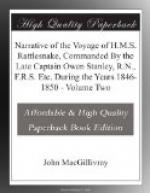No snakes were seen during our rambles, but small lizards occurred everywhere. A large lizard, apparently Monitor gouldii, was shot from a tree on the banks of the river.
INSECTS.
Although not troubled by mosquitoes, such of us as strolled about much in the bush were sadly tormented by sandflies—a minute two-winged insect whose bite raises a small swelling followed by much itching. On going to bed one night, I counted no less than sixty-three of these marks on my left leg from the ankle to halfway up the thigh, and the right one was equally studded with angry red pimples. Among many kinds of ants I may mention the green one, which is found chiefly on trees and bushes, of the leaves of which it makes its nest. Should one unconsciously disturb them by getting entangled among the branches in the neighbourhood of a nest, he may expect a whole swarm upon him before he can extricate himself, and is first made aware of their presence by feeling sharp stinging pains in various places, especially the neck, caused by their bites. A small firefly (a species of Lampyris) is plentiful, showing out at night like a twinkling phosphorescent spark, slowly flitting about from tree to tree or resting on the leaves wet with dew. Nor must I omit a very splendid day-flying moth (Cocytia durvillei) which is common on the skirts of the woods and thickets; several even came on board the ship at various times.
Very few fish were caught at this anchorage, but on the mudflat at the mouth of the creek, shoals of mullet and guard-fish were seen daily. In the fresh water I observed several small species of Cyprinidae rising at flies, but, not being provided with the requisite tackle, none were caught.
SHELLS.
The muddy mangrove-covered banks of the lower part of the creek furnished the collection with an Auricula and a very fine Cyrena, apparently the same as the Australian and New Guinea C. cyprinoides. Many freshwater shells were found in the neighbourhood of the watering-place—three kinds of Melania, a Mytilus, a Navicella, and five species of Neritina—but most of these have been already described as inhabitants of the Feejee Islands and other places in Polynesia, and elsewhere. One might reasonably have anticipated a rich harvest of land-shells in the damp forests of South-east Island, yet diligent search on the trunks of the trees and among the dead leaves about their roots produced only four species, all of which however are new. The finest of these is a Pupina, the giant of its race, of a glossy reddish pink colour with red mouth.
BARTER WITH NATIVES.




